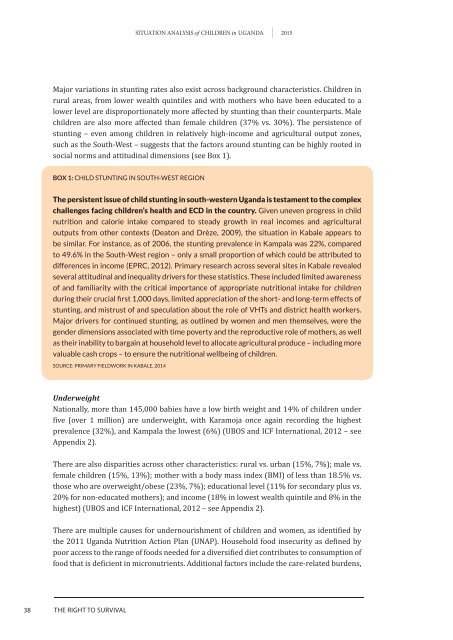Situation analySiS
1TNu802
1TNu802
You also want an ePaper? Increase the reach of your titles
YUMPU automatically turns print PDFs into web optimized ePapers that Google loves.
<strong>Situation</strong> <strong>analySiS</strong> of Children in uganda 2015Major variations in stunting rates also exist across background characteristics. Children inrural areas, from lower wealth quintiles and with mothers who have been educated to alower level are disproportionately more affected by stunting than their counterparts. Malechildren are also more affected than female children (37% vs. 30%). The persistence ofstunting – even among children in relatively high-income and agricultural output zones,such as the South-West – suggests that the factors around stunting can be highly rooted insocial norms and attitudinal dimensions (see Box 1).BOx 1: child stuntinG in south-west reGionthe persistent issue of child stunting in south-western uganda is testament to the complexchallenges facing children’s health and ecd in the country. Given uneven progress in childnutrition and calorie intake compared to steady growth in real incomes and agriculturaloutputs from other contexts (deaton and drèze, 2009), the situation in Kabale appears tobe similar. for instance, as of 2006, the stunting prevalence in Kampala was 22%, comparedto 49.6% in the south-west region – only a small proportion of which could be attributed todifferences in income (eprc, 2012). primary research across several sites in Kabale revealedseveral attitudinal and inequality drivers for these statistics. these included limited awarenessof and familiarity with the critical importance of appropriate nutritional intake for childrenduring their crucial first 1,000 days, limited appreciation of the short- and long-term effects ofstunting, and mistrust of and speculation about the role of vhts and district health workers.major drivers for continued stunting, as outlined by women and men themselves, were thegender dimensions associated with time poverty and the reproductive role of mothers, as wellas their inability to bargain at household level to allocate agricultural produce – including morevaluable cash crops – to ensure the nutritional wellbeing of children.source: primAry fieldworK in KAbAle, 2014UnderweightNationally, more than 145,000 babies have a low birth weight and 14% of children underfive (over 1 million) are underweight, with Karamoja once again recording the highestprevalence (32%), and Kampala the lowest (6%) (UBOS and ICF International, 2012 – seeAppendix 2).There are also disparities across other characteristics: rural vs. urban (15%, 7%); male vs.female children (15%, 13%); mother with a body mass index (BMI) of less than 18.5% vs.those who are overweight/obese (23%, 7%); educational level (11% for secondary plus vs.20% for non-educated mothers); and income (18% in lowest wealth quintile and 8% in thehighest) (UBOS and ICF International, 2012 – see Appendix 2).There are multiple causes for undernourishment of children and women, as identified bythe 2011 Uganda Nutrition Action Plan (UNAP). Household food insecurity as defined bypoor access to the range of foods needed for a diversified diet contributes to consumption offood that is deficient in micronutrients. Additional factors include the care-related burdens,38 thE rIGht to SUrvIvaL




